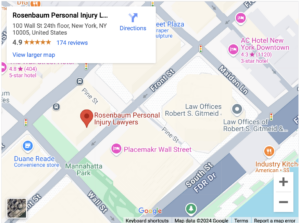No-Fault vs. At-Fault Insurance

The distinction between no-fault insurance and at-fault insurance generally arises in car accident claims, which are the most common type in the personal injury field. Most states are “at-fault” states when it comes to auto insurance. New York, however, is one of about a dozen states that follows a “no-fault” policy. Nevertheless, you can still file a lawsuit against another driver under certain circumstances.
Table of Contents
How No-Fault Insurance Works in New York

Under ordinary circumstances, you do not file a lawsuit against the at-fault party for a car accident in a no-fault state like New York. Instead, you seek compensation from your own Personal Injury Protection (PIP) insurance policy, regardless of who was at fault. You are entitled only to economic losses-–medical expenses and a portion of lost wages, for example. You cannot claim compensation for non-economic losses such as pain and suffering.
Under New York law, you must purchase at least the following auto insurance:
- PIP insurance with a maximum policy limit of at least $50,000 (covering your own economic losses);
- Liability insurance for $25,000 per person/$50,000 per accident/$10,000 per accident property damage; and
- Uninsured and underinsured motorist insurance of $25,000 per person and $50,000 per accident.
These insurance requirements apply to any vehicle that is registered in New York, regardless of where your personal residence is located. This is important because many people who work in New York City actually live in New Jersey or Connecticut.
The Purposes of New York’s No-Fault System
New York has at least two main purposes for implementing a no-fault auto insurance system: The first purpose is to reduce the number of auto accident-related lawsuits. Otherwise, such lawsuits could clog the court system.
The second purpose is to reduce the amount of recoveries for non-economic damages such as pain and suffering. The amount of these damages often far exceeds the amount of medical expenses and lost earnings awarded. The thinking is that litigation costs will spiral out of control in an at-fault auto insurance system.
How At-Fault Insurance Works in New York
Under an at-fault system, you can sue the at-fault driver to recover compensation from the driver or from their liability insurance policy. Although you normally cannot do that in New York, you might need to do so if your expenses exceed the limits of your PIP policy ($50,000 if you purchased the minimum coverage).
In that case, you might want to exit New York’s no-fault system. New York provides a way for you to file a claim against an at-fault driver (and, by extension, their liability insurance company ) so that you can obtain full compensation. For that to happen, your injuries must be “serious” as defined by.5102(d) of the New York Insurance Law. The definition of a “serious” injury under this law includes (but is not limited to) an injury that causes:
- Death, including loss of a fetus;
- Dismemberment;
- A bone fracture;
- Permanent loss of a bodily function; or
- An injury that severely limits your activity for at least three of the six months following your injury.
You might need a lawyer to help you argue that your injuries are “serious” under the foregoing definition.
Available Compensation in At-Fault Personal Injury Claims
In a personal injury lawsuit, New York law allows you to recover for all kinds of losses, both tangible and intangible. Following is a list that includes most of the types of damages personal injury claimants may collect in New York:
- Medical expenses up to the present. Your healthcare provider should be able to confirm this amount.
- Future medical expenses. You will have to estimate these, potentially with the help of an expert.
- Current lost earnings. Your employer can help you document this. If you are self-employed, you will have to do it yourself (with the help of your lawyer, of course).
- Diminished earning capacity. If your injuries prevent you from returning to your old job, you almost certainly need an expert witness to help you calculate your losses.
- Incidental expenses such as child care, medical travel expenses, and house cleaning.
- Property damage. This amount usually refers to damage to your car.
- Physical pain and suffering, emotional distress, diminished quality of life, bodily disfigurement, and loss of consortium.
- Punitive damages. You can only receive punitive damages if the defendant’s conduct was outrageous or perhaps even criminal. Courts very rarely award punitive damages, even when the victim wins the lawsuit.
The items available for compensation in a wrongful death claim are different from the above-listed items, but they are substantial.
Comparative Fault
No matter how serious your injuries are, in a personal injury lawsuit, you cannot recover compensation for any portion of your injuries that are attributable to your own fault. New York courts break this down by percentages.
If the accident was 20% your fault, for example, you will lose 20% of your damages (and you have to pay for 20% of the other party’s damages). If the accident was 90% at fault, you will lose 90% of your damages. This is another ambiguous area where you will probably need a lawyer to argue your case.
Schedule a Free Initial Consultation With an Experienced New York City Personal Injury Lawyer
You might be worried that you can’t afford a lawyer. Never fear, however, because most New York City personal injury lawyers work on a contingency fee arrangement. If your claim is strong, it won’t be difficult for you to find a lawyer willing to take your case.
To discuss your injury case and the compensation you can seek for it in New York, NY, contact our personal attorneys from Rosenbaum Personal Injury Lawyers to schedule a free consultation at (212) 514-5007.



